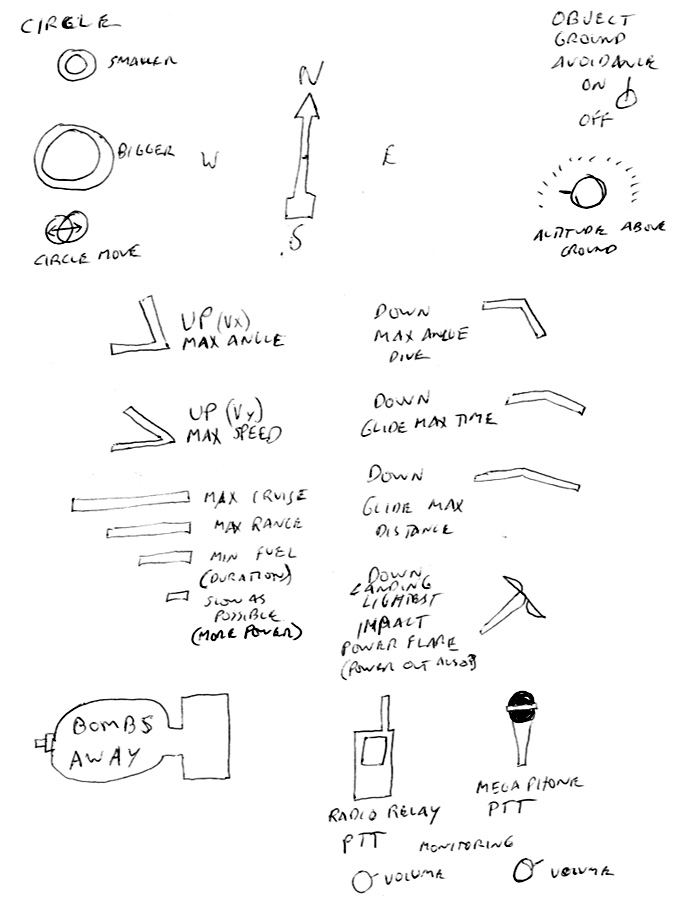
[Para 8] Fig. 1. Shaped button and knob Control Panel. Fig. 1. Shows an aircraft
control panel, that could be used inside an aircraft or on the ground to control
an airborne aircraft. The tabular predictive control system can be programmed
into shaped buttons visually and iconographically describe the flight condition
desired. The buttons can be recognized by touch in the dark or when the operator
is looking at any video returns or if the operator is looking directly at the
UAV and the target. Due to airspace conflicts it may only be possible to operate
some UAVs if the operator has direct visual contact with the UAV. Due to bandwidth
and frequency conflicts and jamming, no video returns may be possible, yet the
UAV can still be used to drop bombs or drop rescue and resupply materiel. No pre-programming
is required and no constant attention from the operator during flight. The simplified
predictive tabular commands consume very little communications bandwidth and only
have to be sent on occasionally as buttons are pressed. Therefore the UAV is more
likely to be able to operate in areas of radio congestion. The operator is less
likely to be radio located and attacked by the enemy. This conception of control
shape and layout and function and algorithm could allow one infantry man to control
the aircraft while simultaneously operating his firearm. The control panel could
be mounted to the firearm and carried as a unit, allowing the infantryman to maintain
simultaneous direct and indirect visual contact with the UAV and the surveillance
area.
[Para 9] On the top left the buttons labeled circle command the aircraft into
a circling position. "Smaller" and "Bigger" circle buttons
widen and shrink the diameter of the circle the aircraft is flying. Below the
"Circle Move" knob acts as a trim type joystick to nudge the circle
over a different spot. Compensation for cross winds if it existed would be on
the aircraft itself, otherwise in a simple low cost system the operator could
compensate for conditions by occasional presses of the circle move button.
[Para 10] In the center of the top is a compass like control which can be rotated
to communicate to the aircraft its desired magnetic heading, unless it is circling.
[Para 11] On the top right is an on/off switch that turns on any available system
that detects the proximity of the ground or objects and climb above them.
[Para 12] The knob below the ground avoidance knob is the adjustment of the desired
altitude above the ground that the ground avoidance system maintains.
[Para 13] In the middle left of the control panel there are two commands that
create the climbing conditions well known as Vx and Vy. Below that there are level
flight commands of the well known conditions of level flight, maximum cruise,
maximum range, minimum fuel consumption, and minimum speed flight.
[Para 14] In the middle right of the control panel are three downward flight commands,
maximum downward climb angle, maximum duration glide, maximum distance glide.
Below that there is a different downward flight command, a "behind the power
curve" command associated with the landing flare.
[Para 15] On the bottom of the control panel on the left is the bomb or supply
drop button safety cover. In the middle is the radio shaped radio relay push to
talk button. In this case the transmitter is on the aircraft and the sound is
transmitted to the aircraft by a different means or frequency than the transmitter
on the aircraft. This serves to strengthen the communication over long distances
while helping to hide the direction and location of the operator from enemy detection.
Below is a volume knob for the heard radio sound from the UAV that goes to the
operators headset. On the right of the bottom of the control panel is a microphone
shaped button which when pressed operates a bullhorn or public address system
on the UAV which allows the operator to shout at persons on the ground. Below
is a volume knob for the heard sound from the UAV that goes to the operators headset,
if the UAV is quiet enough operate a microphone successfully, noise cancellation
could be applied at the source and other means.
